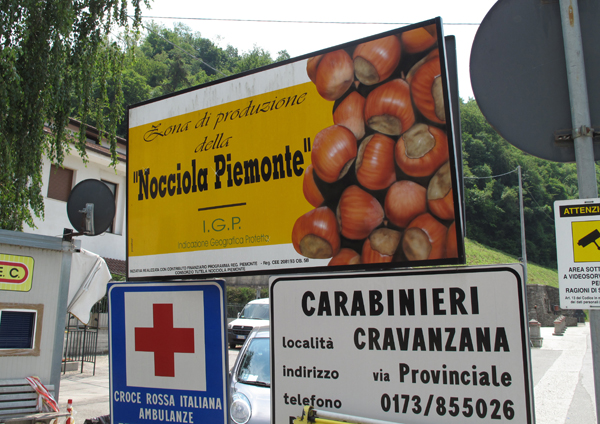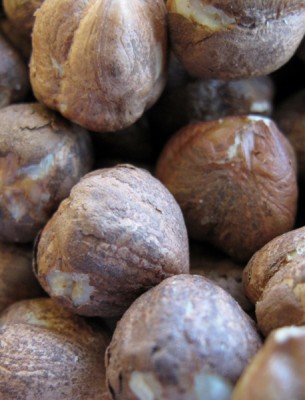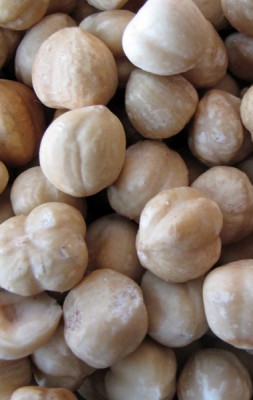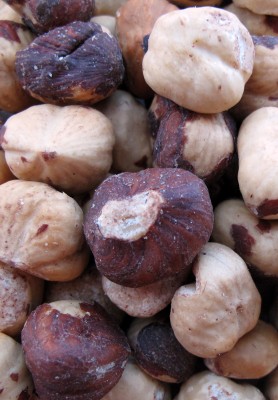
The dominant hazelnut cultivar in Piedmont is Tonda Gentile delle Langhe (or TGL, for short). Tonda Gentile delle Langhe translates as “round and mild (or delicate or refined) of the Langhe,” referring to the spherical kernel, its sweetness of flavor, and the cultivar’s origins in the Langhe hills southeast of Turin in the province of Cuneo.

Tonda Gentile delle Langhe, with pellicle.
There are over four hundred cultivars of C. avellana. Of those, twenty account for nearly all of the world’s commercial hazelnut production. Though Tonda Gentile delle Langhe is far from the most consequential cultivar in terms of its quantitative contribution to world production, it is widely regarded for its quality.
It would be easy for a casual observer to dismiss enthusiasm for Tonda Gentile delle Langhe as a product of marketing hype or regional pride (1). It might be difficult to imagine that this relatively minor cultivar could really be all that distinguishable from, say, the well-respected Tonda di Giffoni of Campania, Tonda Gentile Romana of Lazio, Negret of Spain, or Tombul of Turkey. Closer examination, however, reveals that the cultivar deserves its reputation for excellence.
TGL’s morphological characteristics—particularly kernel size and shape—make it attractive in confectionery. The cultivar consistently produces a medium sized kernel (12-13 mm in diameter) (2). This is considered ideal in the industry, as smaller nuts may be underdeveloped or shriveled, while larger nuts are generally sold for direct consumption (3).

Tonda Gentile delle Langhe kernels.
TGL also produces very round kernels, with a roundness index very close to 1 (i.e., perfectly round) (4). Round kernels withstand mechanical shelling with less damage than oblong kernels. Less damage means less economic loss. More importantly, for aesthetic purposes, confectioners value whole kernels more highly than broken ones (5).
Another desirable quality of TGL is the exceptional ease of pellicle removal after roasting. The pellicle is the thin, brown “skin” encasing the kernel of the shelled nut. After roasting, the pellicle ideally becomes brittle and easily separable from the kernel with light friction. With Tonda Gentile delle Langhe, over 90%—and often closer to 100%—of the pellicle is removable (when anything above 85% is generally considered optimal for a cultivar) (6). For comparison, the dominant cultivar in Oregon, Barcelona, typically sheds about half of the pellicle (7).

Oregon hazelnuts, cv. Barcelona (Freddy Guys)
Pellicle removal is critical for two reasons. First, the pellicle is rich in tannins; the more complete the removal, the lower the bitterness and astringency of the kernel. Second, the pellicle is tough enough that it resists homogenization in grinding, resulting in an unpleasant grittiness (8).
While fat content in hazelnuts can range from 50% to over 70%, “an average content of 62-65% ensures a harmonious expression of the flavor, aroma, and texture of the hazelnut” (9). Lower fat content results in less intensity of flavor and aroma, while higher fat content leads to more rapid rancidification. The fat content of Tonda Gentile delle Langhe generally ranges from 62 to 65%, making it ideal for confectionery (10).
Tonda Gentile delle Langhe excels in every objective measure of hazelnut quality for confectionery. But, subjectively, do the nuts taste better?
Notes:
1. Though the nationalism of the Fascist era is past, modern Italian pride in regional products occasionally smacks of culinary fetishism and economic protectionism.
2. Tombesi, A., and F. Limongelli. “Varietà e Miglioramento Genetico del Nocciolo.” 2° Convegno Nazionale sul Nocciolo. Giffoni Valle Piana. 2002. P. 14. See also, Cristofori, Valerio. Fattori di Qualità della Nocciola. Tesi di Dottorato di Ricerca. Università degli Studi Tuscia di Viterbo, Dipartimento di Produzione Vegetale, Sezione Ortofloroarboricoltura. 2005. P. 125.
3. Cristofori, 24.
4. Bottazzi, Marco, Piero Romisondo, Claudio Salaris, Gianni Bernard, and Giacomo Iacurti. “New Hazelnut Hybrids,” Proceedings of the III International Congress on Hazelnut. Acta Horticulturae: 351. 1992. P. 126. See also, De Salvador, F.R., M. Giorgioni, D. Massari, S. Bizzarri, P. Onorati, and F. Kaswalder. “La Collezione di Vico Matrino (VT) per il Rinnovo Varietale ed il Miglioramento Qualitativo del Nocciolo.” 2° Convegno Nazionale sul Nocciolo. Giffoni Valle Piana. 2002. P. 176. See also, Miljkovic, I., and Z. Prgomet. “Comportamento di Otto Cultivar di Nocciolo in Istria (Croazia),” Proceedings of the III International Congress on Hazelnut. Acta Horticulturae: 351. 1992. P. 108.
5. Cristofori, 24.
6. McCluskey, R.L., A.N. Azarenko, S.A. Mehlenbacher, and D.C. Smith. “Commercial Hazelnut Cultivar and Advanced Selection Evaluations at Oregon State University,” Proceedings of the Fifth International Congress on Hazelnut. Acta Horticulturae: 556. 2001. P. 91. See also, Farinelli, D., M. Boco, and A. Tombesi. “Ulteriore Valutazione di Genotipi di Nocciolo (C. avellana) Ottenuti Mediante Incrocio tra le cv. Tonda Romana e Tonda di Giffoni.” 2° Convegno Nazionale sul Nocciolo. Giffoni Valle Piana. 2002. P. 162. See also, Valentini, N., G. Me, and R. Vallania. “New Hazelnut Selections for Direct Consumption,” Proceedings of the Fifth International Congress on Hazelnut. Acta Horticulturae: 556. 2001. P. 105.
7. McCluskey, et al., 91. See also, Mehlenbacher, Shawn A., David C. Smith, and Rebecca L. McCluskey. “‘Sacajawea’ Hazelnut,” HortScience, Vol. 43(1), February 2008. P. 255.
8. Cristofori, 24-5.
9. Cristofori, 25.
10. Ebrahem, K.S., D.G. Richardson, R.M. Tetley, and S.A. Mehlenbacher. “Oil Content, Fatty Acid Composition, and Vitamin E Concentration of 17 Hazelnut Varieties, Compared to Other Types of Nuts and Oil Seeds,” Proceedings of the III International Congress on Hazelnut. Acta Horticulturae: 351. 1992. P. 687. See also, De Salvador, et al., 177. See also, Cristofori, 131.
